 Browns Archive
Browns Archive  Blast From The Past: Joe D of the Kardiac Kids
Blast From The Past: Joe D of the Kardiac Kids
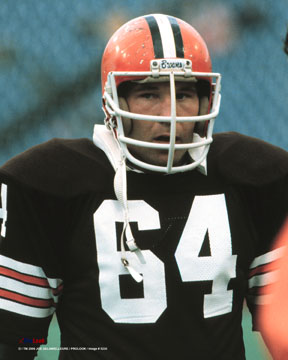 By 1980, the boy had turned 18. His interests had begun to transition away from sports, to the general avoidance of growing up.
By 1980, the boy had turned 18. His interests had begun to transition away from sports, to the general avoidance of growing up.
His Cleveland Browns were respected on a national level; they were a proud franchise that had long been a pillar of professional football. It had been several seasons since they were title contenders, though, and by the end of the ‘70s, nobody expected them to challenge again as such anytime soon.
So the boy was looking the other way when the Sam Rutigliano-led Browns began to emerge as an offensive powerhouse. Ozzie Newsome was helping to revolutionize the tight end position; he was a matchup nightmare as a large-body receiver with some speed and great hands. Multi-purpose threat Greg Pruitt was hobbled by nagging injuries, but Mike “No Relation” Pruitt was establishing himself as a top powerback. Receivers Reggie Rucker, Dave Logan and Ricky Feacher were all dependable and dangerous. Quarterback Brian Sipe was becoming a household name as he and Coach Sam transformed the Browns into the Kardiac Kids- who seemed to rally from behind on a weekly basis to win games in dramatic fashion.
The offensive line was acknowledged as a strength of the team. On the left side were tackle Doug Dieken and guard Henry Sheppard. On the right side were tackle Cody Risien and guard Robert E. Jackson. The center was Tom DeLeone. The line was solid at every position. Other than DeLeone, they were tall, rangy, seasoned pass-blockers. Offensive line chemistry is important, and the Browns’ line had it.
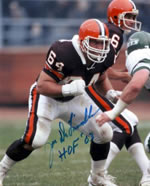 Just prior to the start of the season, the Browns pulled the trigger on a trade with the Buffalo Bills. The Browns sent the Bills a second round pick in 1982 and a third round pick in 1983 for All-Pro guard Joe DeLamielleure. It was a head-scratcher, since conventional wisdom held that the defense was where the Browns had holes. Also, ‘Joe D’ was considered to be more of a run-blocker. And again, the Browns weren’t considered to be contenders, and figured to need those picks. Observers close to the team assumed that Dieken’s contract holdout in training camp that year may have prompted the Browns to seek some depth. The solid character of the linemen was such that the resulting demotion of Jackson did not adversely affect their play.
Just prior to the start of the season, the Browns pulled the trigger on a trade with the Buffalo Bills. The Browns sent the Bills a second round pick in 1982 and a third round pick in 1983 for All-Pro guard Joe DeLamielleure. It was a head-scratcher, since conventional wisdom held that the defense was where the Browns had holes. Also, ‘Joe D’ was considered to be more of a run-blocker. And again, the Browns weren’t considered to be contenders, and figured to need those picks. Observers close to the team assumed that Dieken’s contract holdout in training camp that year may have prompted the Browns to seek some depth. The solid character of the linemen was such that the resulting demotion of Jackson did not adversely affect their play.
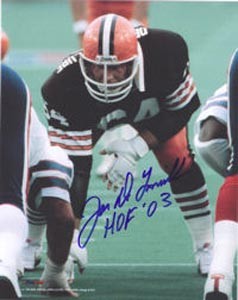 DeLamielleure was coming off a contract dispute of his own in Buffalo. Joe D would later say that head coach Chuck (“Ground Chuck”) Knox rubbed him the wrong way by paying younger players more. He admits to acting immaturely, even as a seven-year veteran. He still maintains that Knox turned down better offers for him, and agreed to the deal with the Browns because he assumed they would be a bad team.
DeLamielleure was coming off a contract dispute of his own in Buffalo. Joe D would later say that head coach Chuck (“Ground Chuck”) Knox rubbed him the wrong way by paying younger players more. He admits to acting immaturely, even as a seven-year veteran. He still maintains that Knox turned down better offers for him, and agreed to the deal with the Browns because he assumed they would be a bad team.
Acting immaturely? It is believable that DeLamielleure was strong-headed; more on that later. Regardless, the trade to Cleveland actually made owner Art Modell and Peter Hadhazy (the only general manager ever hired by Modell) look smart. That is, not self-serving or petty (but I digress). The deal paid dividends via the versatility and depth it provided to the line. A prime example was when Diek went down with a bad knee. He started the following game to keep a games-started streak intact (foreshadowing a Newsome games-with-a-catch streak years later) and promptly returned to the bench. Sheppard moved over to left tackle, DeLamielleure was inserted at left guard, and Robert E. Jackson assumed his customary right guard position. The line didn’t appear to miss a beat.
Years later, Joe D described his thoughts upon having been traded to the Browns. He recalled walking into the stadium at Baldwin-Wallace (where Browns training camp was held in those days). He saw retired players such as Marion Motley and Bill Willis, and came to learn who they were and the impact they had (not just with the Browns, but with sports in general. They were stars on the Browns as early as 1946- a full year before Jackie Robinson debuted for baseball’s Brooklyn Dodgers.).
He was glad to remain close to his Detroit roots, because his father could watch his games on television. The elder DeLamielleure owned a bar there, where Joe D had worked doing odd jobs going back to his early childhood.
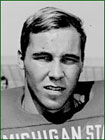 The lineman had attended and played for Michigan State in his college years. He originally leaned toward Bo Schembechler (he was Bo’s first recruit) and the University of Michigan before his father convinced him to join the Spartan’s head coach, Duffy Daugherty. Dad- and son- appreciated the Roman Catholic leanings of the coach. They also appreciated the life lessons Daugherty shared (and his favorite saying: “To be a great football player, you need three bones- a backbone, a wishbone, and a funny bone.”).
The lineman had attended and played for Michigan State in his college years. He originally leaned toward Bo Schembechler (he was Bo’s first recruit) and the University of Michigan before his father convinced him to join the Spartan’s head coach, Duffy Daugherty. Dad- and son- appreciated the Roman Catholic leanings of the coach. They also appreciated the life lessons Daugherty shared (and his favorite saying: “To be a great football player, you need three bones- a backbone, a wishbone, and a funny bone.”).
After his senior season, DeLamielleure played in the 1973 Senior Bowl. Two of his coaches were Lou Saban, head coach of the Bills, and Jim Ringo, the Bills’ offensive line coach and famous Packers lineman. The coaches saw the legendary Joe D work ethic, the quick study, the solid personality. At the Senior Bowl weigh-in late in the week, the 6’ 3” player was concerned that he’d lost some pounds off his 255 lb playing weight. He got on the scale and saw ’243’- before Ringo applied his foot to the scale and shouted “255” to the observers in the room. Ringo and Saban played Joe D at tackle in the game, which confused the player but apparently was designed to find out how versatile he was. As luck would have it, he was lined up against another player from Detroit with whom DeLamielleure was familiar, and Joe D had a good game.
But it was the Pittsburgh Steelers who communicated most with DeLamielleure in the weeks approaching the draft. The Steelers also had former Spartan coaches on their staff in George Perles and Woody Widenhofer.
The NFL draft was not televised then, and Joe D had a test to take during the time it was held. His wife had agreed to raise the window shades once he got drafted, as a signal - but when he returned from his test, the blinds remained down. They figured the draft was into the fourth round by now. The phone soon rang, and confusion ensued. A Mr. Wilson introduced himself and told Joe D he had been selected in the first round. Well, the player did not realize that Mr. Ralph Wilson was the Buffalo owner- he thought he’d been drafted by the Steelers! That’s what he told his father. He then received a call from a Buffalo sports writer, Larry Felser. Felser wanted to talk about the Bills, which left DeLamielleure wondering if he’d been traded. The writer straightened Joe D out- and would one day introduce the player at his NFL Hall of Fame speech.
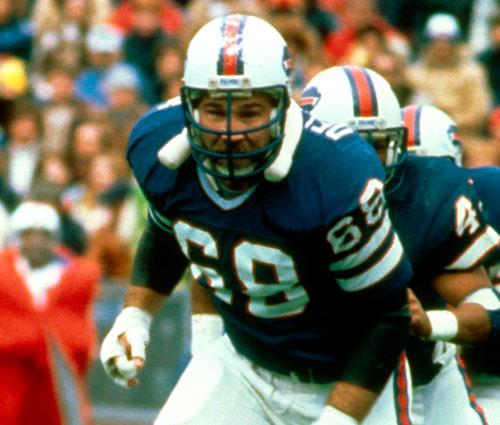
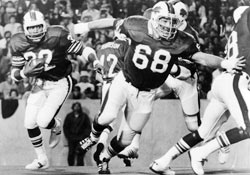 Joe DeLamielleure’s career with Buffalo was begun with an NFL Rookie of the Year season. He became famous as the leader of ‘The Electric Company’, the offensive line that blocked for O.J. Simpson, ‘The Juice’ (today, DeLamielleure laments the innocent victims of the murders of which Simpson was accused, but maintains that while they were teammates, Simpson was a model teammate who lacked a superstar attitude). Behind that line, Simpson became the first runner to rush for over 2,000 yards- and the only one ever to do that in a 14 game season. The Bills’ offense was one of the best in the league in the 1970s; when Simpson was traded to San Francisco in 1978, Bills running back Terry Miller finished 9th in the league in rushing. (Just as interesting to me were the other various NFLPA awards Joe D won, such as the AFC arm wrestling championship in 1978 as well as various racquetball titles.)
Joe DeLamielleure’s career with Buffalo was begun with an NFL Rookie of the Year season. He became famous as the leader of ‘The Electric Company’, the offensive line that blocked for O.J. Simpson, ‘The Juice’ (today, DeLamielleure laments the innocent victims of the murders of which Simpson was accused, but maintains that while they were teammates, Simpson was a model teammate who lacked a superstar attitude). Behind that line, Simpson became the first runner to rush for over 2,000 yards- and the only one ever to do that in a 14 game season. The Bills’ offense was one of the best in the league in the 1970s; when Simpson was traded to San Francisco in 1978, Bills running back Terry Miller finished 9th in the league in rushing. (Just as interesting to me were the other various NFLPA awards Joe D won, such as the AFC arm wrestling championship in 1978 as well as various racquetball titles.)
So Joe D’s reputation as a dominant run blocker was well-earned. But once he arrived in Cleveland, Brian Sipe threw for over 4,000 yards on his way to becoming the NFL’s Most Valuable Player.
After five seasons with the Browns, Joe DeLamielleure was traded back to Buffalo for one final season. Upon retirement, he has stayed active in his personal life. He was an assistant coach at Duke for a short time, under Sam Rutigliano (Joe D recruited current Browns tight end Benjamin Watson). He played a few games with the Charlotte Rage of the Arena League. He worked as a groundskeeper, and tried his hand at broadcasting. He currently sells a line of exercise bands, which you can check out with a Google search.
His charity work remains solid. One of his MSU roomates, John Shinsky (from St. Joe’s in Cleveland), had grown up in an orphanage and has since opened two orphanages in Mexico. DeLamielleure (who has two adopted children) rode a bicycle the 2,000 miles from Michigan State to Mexico in 18 days to raise money for those facilities. He had never ridden a bicycle until several days prior to the trip! He intends his next effort to be climbing Mt. Kilimanjaro in Africa, in support of the U.S. Wounded Warrior Project.
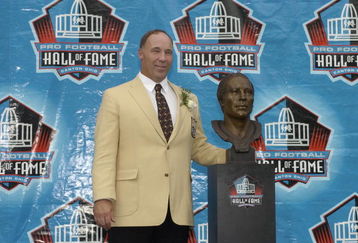 So his work ethic remains. And the strong-headedness. And this also played out during this past year’s NFL labor negotiations. Joe D- who often had been identified by former NFLPA president Gene Upshaw as not demanding enough contract money- was among the most vocal ex-players. He insisted that more current NFL money needs to go to the assistance of retirees. His pension from his 13-year career is under $1300 per month. He notes that other Hall of Fame players get under $200/month. He calls his generation part of the “guinea pig society”- referring to the 1960s through the 1980s, when the league dabbled with hazardous Astro turf; players were taught to lead with their head; offensive linemen endured legal head slaps; teams practiced three times a day; salt pills were used (and if you were big you got more). DeLamielleure played special teams all through his Buffalo years and was the heart of their wedge (which is now outlawed). A big reason Joe D’s stand against the players' union was so brave is that the leadership can control the earning potential of Hall of Fame players by regulating their speaking, endorsement, and appearance opportunities.
So his work ethic remains. And the strong-headedness. And this also played out during this past year’s NFL labor negotiations. Joe D- who often had been identified by former NFLPA president Gene Upshaw as not demanding enough contract money- was among the most vocal ex-players. He insisted that more current NFL money needs to go to the assistance of retirees. His pension from his 13-year career is under $1300 per month. He notes that other Hall of Fame players get under $200/month. He calls his generation part of the “guinea pig society”- referring to the 1960s through the 1980s, when the league dabbled with hazardous Astro turf; players were taught to lead with their head; offensive linemen endured legal head slaps; teams practiced three times a day; salt pills were used (and if you were big you got more). DeLamielleure played special teams all through his Buffalo years and was the heart of their wedge (which is now outlawed). A big reason Joe D’s stand against the players' union was so brave is that the leadership can control the earning potential of Hall of Fame players by regulating their speaking, endorsement, and appearance opportunities.
But Joe is just Joe. A very genuine and forthright ex-player. As down-to-earth as they come (in the 1980s, he was known to attend Browns home games, just mixed in with the rest of the crowd). A Hall of Famer. And just a really solid role model to a young fan who was shown a lesson or two on growing up, once he began to take notice.
Thank you for reading.
Joe D and Robert E Jackson ahead of Dino Hall, with Brian Sipe in the background.
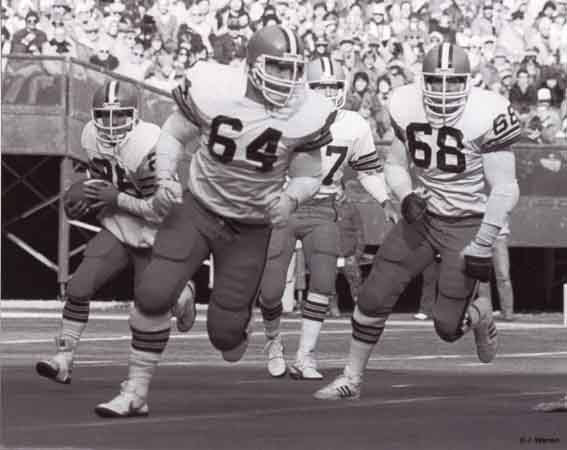
- NBA Announces 2013-2014 Schedule
- Browns Ink Sharknado
- Sharknado A No-Show For Rookie Camp
- Trent Richardson Out Until Training Camp
- Browns Sign Brandon Jackson
- Carrasco Suspended Eight Games
- Browns Add to Wide Receiver Depth with David Nelson
- Browns Need to Learn from Past Draft Mistakes
- Browns Release Chris Gocong and Usama Young
- Browns Missing on Grimes Disappointing, But Not The End
The TCF Forums
- Official- Browns Coach Search/Rumors
mattvan1 (Tuesday, January 21 2014 1:19 PM) - Movies coming out
rebelwithoutaclue (Tuesday, January 21 2014 12:56 PM) - 2015 Recruiting
jclvd_23 (Tuesday, January 21 2014 12:38 PM) - The 2014 Offseason Thread
Larvell Blanks (Tuesday, January 21 2014 12:25 PM) - Chris Grant's first 3 drafts
Kingpin74 (Tuesday, January 21 2014 10:13 AM) - Mike Brown
YahooFanChicago (Monday, January 20 2014 11:15 PM) - 2014 Hoops Hockey Hijinx
jpd1224 (Monday, January 20 2014 4:44 PM) - 2014 Recruiting
jclvd_23 (Monday, January 20 2014 2:26 PM) - Wish List - #4 Pick
Hikohadon (Monday, January 20 2014 1:26 PM) - #1 overall pick Anthony Bennett
TouchEmAllTime (Sunday, January 19 2014 1:28 PM)



